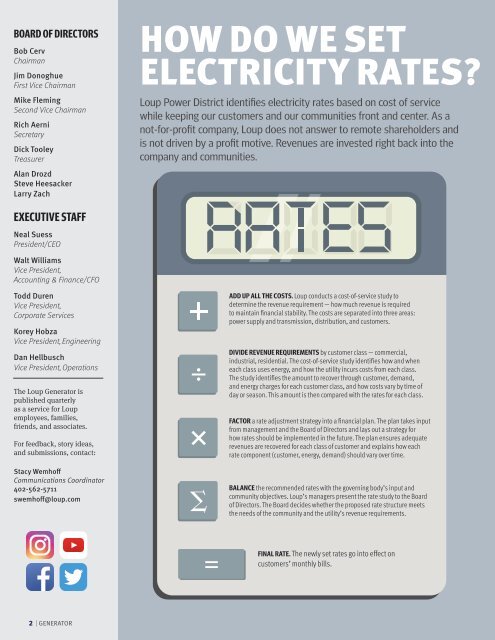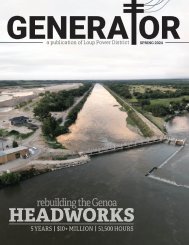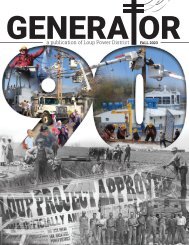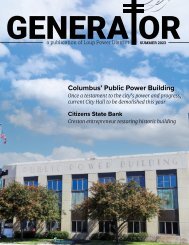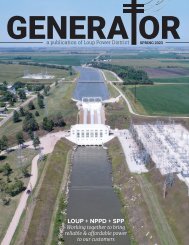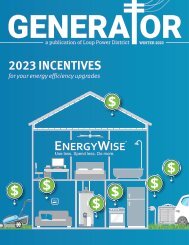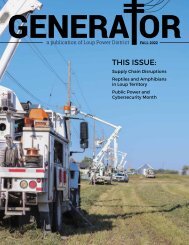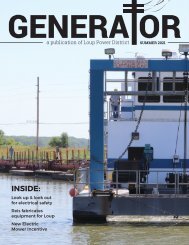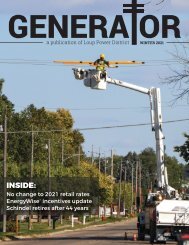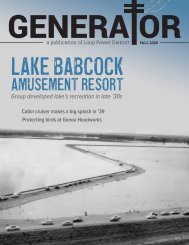Winter 2024 Generator
Topics in this issue include a 2024 rate increase, a lineman's perspective on the power restoration, and 2024 EnergyWise incentives.
Topics in this issue include a 2024 rate increase, a lineman's perspective on the power restoration, and 2024 EnergyWise incentives.
Create successful ePaper yourself
Turn your PDF publications into a flip-book with our unique Google optimized e-Paper software.
BOARD OF DIRECTORS<br />
Bob Cerv<br />
Chairman<br />
Jim Donoghue<br />
First Vice Chairman<br />
Mike Fleming<br />
Second Vice Chairman<br />
Rich Aerni<br />
Secretary<br />
Dick Tooley<br />
Treasurer<br />
Alan Drozd<br />
Steve Heesacker<br />
Larry Zach<br />
HOW DO WE SET<br />
ELECTRICITY RATES?<br />
Loup Power District identifies electricity rates based on cost of service<br />
while keeping our customers and our communities front and center. As a<br />
not-for-profit company, Loup does not answer to remote shareholders and<br />
is not driven by a profit motive. Revenues are invested right back into the<br />
company and communities.<br />
EXECUTIVE STAFF<br />
Neal Suess<br />
President/CEO<br />
Walt Williams<br />
Vice President,<br />
Accounting & Finance/CFO<br />
Todd Duren<br />
Vice President,<br />
Corporate Services<br />
Korey Hobza<br />
Vice President, Engineering<br />
Dan Hellbusch<br />
Vice President, Operations<br />
The Loup <strong>Generator</strong> is<br />
published quarterly<br />
as a service for Loup<br />
employees, families,<br />
friends, and associates.<br />
For feedback, story ideas,<br />
and submissions, contact:<br />
Stacy Wemhoff<br />
Communications Coordinator<br />
402-562-5711<br />
swemhoff@loup.com<br />
ADD UP ALL THE COSTS. Loup conducts a cost-of-service study to<br />
determine the revenue requirement — how much revenue is required<br />
to maintain financial stability. The costs are separated into three areas:<br />
power supply and transmission, distribution, and customers.<br />
DIVIDE REVENUE REQUIREMENTS by customer class — commercial,<br />
industrial, residential. The cost-of-service study identifies how and when<br />
each class uses energy, and how the utility incurs costs from each class.<br />
The study identifies the amount to recover through customer, demand,<br />
and energy charges for each customer class, and how costs vary by time of<br />
day or season. This amount is then compared with the rates for each class.<br />
FACTOR a rate adjustment strategy into a financial plan. The plan takes input<br />
from management and the Board of Directors and lays out a strategy for<br />
how rates should be implemented in the future. The plan ensures adequate<br />
revenues are recovered for each class of customer and explains how each<br />
rate component (customer, energy, demand) should vary over time.<br />
BALANCE the recommended rates with the governing body’s input and<br />
community objectives. Loup’s managers present the rate study to the Board<br />
of Directors. The Board decides whether the proposed rate structure meets<br />
the needs of the community and the utility’s revenue requirements.<br />
FINAL RATE. The newly set rates go into effect on<br />
customers’ monthly bills.<br />
2 | GENERATOR


